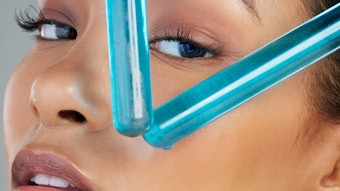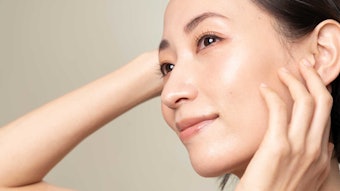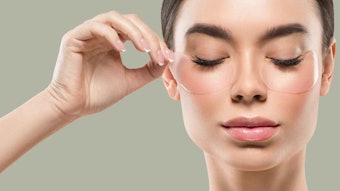
My interest in the effects of carboxylic acids on hair began many years ago, after serendipitously generating data that suggested how soaking tresses in a 5% citric acid solution lowered hair’s water content (see Figure 1). Initially, this may seem a totally undesirable outcome, as consumers worry greatly about hair drying out” and subsequently demand products that “moisturize” and “hydrate.” Yet, earlier articles in this column have addressed how sensorial and mechanical properties of hair are greatly compromised by increased water content1, 2—and there is now a general consensus among hair scientists that water is detrimental to hair properties and aesthetics. Therefore, the ability to lower hair’s moisture content is intriguing.
Further work suggested nothing unique about citric acid; solutions of all carboxylic acids tested, e.g., lactic, succinic, adipic, glycolic, etc., showed similar effects, albeit to differing extents. No effects were observed for treatments with mineral acids; for instance, hydrochloric acid.
Further evidence for the interesting effect of these acids comes from differential scanning calorimetry (DSC) experiments, wherein hair soaked in such solutions showed a marked increase in protein denaturation temperature—in some instances by up to 10°C.
In recent years, the effects of carboxylic acids on hair are becoming better recognized and products touting their benefits are finding their way onto shelves. In some instances, these materials are included at low, presumably ineffectual levels to help tell a marketing story; at the same time, products containing higher levels exist. Glyoxylic acid treatments are now being pushed as an alternative to Brazilian Keratin products,3 while a disruptive product claiming to induce new cross-links in the hair is based on maleic acid.
This article explores the efficacy of these materials and presents possible explanations for their effectiveness.
Let Us Not Forget Historical Literature
The ability for ninhydrin to lower the water content of hair and wool is well-documented in scientific literature.4 This mechanism is believed to involve simple steric effects, wherein molecules penetrate hair and obstruct sites where water would otherwise adsorb. Scrutiny of the historical scientific literature shows how similar effects relating to carboxylic acid solutions and hair are not new, since papers on the subject date back to the 1950s.5, 6
The pH of these solutions is seemingly prohibitively low for use in any hair care treatment (~1.7-1.9); however, adjustment to more reasonable levels results in the reduction of both water-retarding and DSC effects. Specifically, efficacy appeared to be lost when the pH was raised through the pKa of the acid (generally around 3.8). This led us to an interest in phenols, which are acidic in nature but possess a much higher pKa (generally around 9.5).
Reassuringly, soaking hair in a selection of phenolic solutions, e.g., phenol, resorcinol and pyrogallol, resulted in similarly altered adsorption isotherms. Once again, historical papers were later discovered—this time from the 1960s—which had beaten us to this finding.7
Mechanistic Considerations
Unquestionably, hair treated by these acid (and phenol) solutions feels quite different. To use consumer expressions, hair tresses feel thicker, fuller and more voluminous, and differences in hair properties can be quantified that possibly shed light on the reason for these perceptions.
Figure 2 shows how soaking hair in a 5% citric acid solution raises the cross-sectional area of fibers by approximately 150 µm2; a 5% resorcinol solution causes an approximate 300 µm2 change. Based on an average-sized 70 µm hair fiber (cross sectional area of 3,820 µm2), these results represent dimension increases of around 4% and 8%, respectively—which would be greater still for finer hair. In terms of an explanation, it appears reasonable to believe that incursion and retention of materials inside the hair must lead to some degree of fiber expansion.
In recent years, the effects of carboxylic acids on hair are becoming better recognized and products touting their benefits are finding their way onto shelves.
As discussed in previous articles, water is a plasticizer of hair—therefore, the ability to lower the moisture content should result in higher mechanical properties. Figure 3 shows the Young’s modulus for the same hair treated with 5% citric acid and resorcinol solutions, and illustrates the expected increase in this parameter. Increased fiber stiffness and higher dimensions are both thought to be key components/contributors to hair volume and body,8 so we can rationalize the aforementioned observations in terms of these hitherto unobtainable property changes.
Accordingly, a coherent theory exists wherein carboxylic acids and phenols penetrate into fibers to occlude water adsorption sites by steric means. Further to this point, larger molecules were generally observed to produce more sizable effects, although solubility clearly suffers with increasing molecular weight. A higher denaturing temperature would also be in line with depleted water content. Moreover, these effects are totally reversible, —with changes being lost after dialysis. This again implies no chemical reactivity and effects are believed to be solely adsorption-related. Another more recent article also professes this mechanism.9
Alternate Explanations
While it is clear that the properties of hair are changed, there may be alternative explanations for the cause. The effect of pH on the protein denaturation temperature of hair has been documented relatively recently by Istrate and coworkers.10 Figure 4 shows TRI’s own comparable results for such a study and demonstrates how pH itself has a considerable effect on the denaturing temperature. Therefore, a moisture mitigation explanation is not required to explain the soaring denaturing temperature that arises from an acid soak. Instead, this occurrence can be simply explained as an artifact of lower pH conditions.
Delving into still-older scientific literature reveals evidence for the remarkably strong affinity of acids for hair.11, 12 Titration curves illustrate a steep increase in acid uptake with decreasing pH; such that, at a pH of around 1.5, approximately 0.8 millimoles of acid can be adsorbed per gram of hair. Therefore, in theory, soaking in a citric acid solution (RMM = 192.2 g/mol) would result in the uptake of approximately 0.15 g per 1 gram of hair—in short, 15% by weight.
This surprisingly high value has implications for our adsorption experiments. Dynamic Vapor Sorption (DVS) is a gravimetric adsorption approach wherein the water content of hair is monitored in terms of its weight as a function of the relative humidity.1 The degree of adsorption, sometimes termed the regain, is expressed as a percentage based on the initial weight of the sample. However, the initial weight of our treated hair sample now seemingly does not consist of 100% hair; rather, in theory, it would consist of only 85% hair and 15% adsorbed acid. Accordingly, adsorption values are calculated based on an overly high weight of hair, which subsequently manifests as an apparent decrease in regain. Thus, seemingly altered isotherms could be an artifact of this convoluted sample weight.
Continuing with this line of thought, we obtain a potential explanation for why larger molecules apparently produce greater DVS efficacy. That is, conversion from moles to grams involves multiplying by the molecular weight. By means of example, 0.8 millimoles of adsorbed glycolic acid (a rather small acid; RMM = 76 g/mol) corresponds to only 0.06 g of acid per 1 gram of hair (i.e., 6% by weight). In short, larger molecules with higher molecular mass translate into higher weight percentages for an equivalent molar concentration. This idea also provides an explanation for lack of activity when soaking in hydrochloric acid (mineral acids): HCl is a gas and would volatilize. The steepness of the titration curves similarly provides an explanation for decreased activity when raising the pH to levels more acceptable for product formulation.
Penetration
Irrespective of the mechanism, and from a product development standpoint, the properties of treated hair are clearly altered in intriguing, and possibly hitherto unobtainable, ways. Yet there is seemingly a hindrance in terms of the time needed to induce such effects. Figure 5 shows DVS water reduction results for hair samples treated with a 5% citric acid solution as a function of soak time at two different temperatures. Results suggest that surprisingly prolonged contact times are necessary for this molecule to diffuse completely into hair and produce its full effect.
The idea of changing hair properties from the inside provokes intriguing possibilities. It is exciting to recognize a whole new category of hair treatment products might be out there, still waiting to be developed.
Water readily diffuses into hair; this possibly has led to a thought process within our industry that anything dissolved or dispersed in an aqueous base will go along for the ride. Figure 5 refutes that belief.
A more realistic scenario might be to think of a hair fiber as a micro chromatography column. In liquid chromatography, the solvent readily traverses the column, while dissolved materials move at differing rates based on their size and interaction with the column material. By analogy, in hair, solutes must permeate through the fiber’s complex structure while all the time under the influence of chemical interactions associated with protein constituents. By this rationale, incursion of materials into hair no longer appears a trivial occurrence.
Summary
There appears to be ample evidence to show that the properties of hair can be altered in interesting ways by treatment with carboxylic acids—yet the mechanism is not yet clear.
Acids have an affinity for hair, and a suggestion has been made that adsorbed species can reduce water uptake by binding/blocking sites in which water would otherwise adsorb. Altered adsorption isotherms, increased mechanical properties and elevated denaturing temperatures may all be taken as evidence for this positioning. Commercial products purporting to prolong style longevity are similarly in line with this reasoning.
Yet, a simpler explanation may exist that does not require the manipulation of water content. Here, considerable internal deposition “plumps up” hair dimensions and impacts mechanical properties. DVS results become the consequence of an experimental weighing artifact, while DSC findings relate simply to underlying pH solution effects.
Further, relating to DSC denaturation results, it is well-recognized that this transition temperature decreases as a consequence of certain insults that compromise, or “damage,” the hair structure. Therefore, to some, the ability for an ingredient or product to raise this value (no matter how slight) is considered an indication of “repair.” Yet, as shown herein, and as recently noted by Popescu and Gummer,13 such results could easily be a pH artifact.
Nonetheless, the idea of changing hair properties from the inside provokes intriguing possibilities. Conventional daily-use products, i.e., shampoos, conditioners and styling products, seemingly act solely on the hair surface—however, certain hair properties are dictated by the internal cortical structure, and their manipulation therefore necessitates the penetration of materials deep into the hair. Results shown herein suggest how even relatively small acids penetrate rather slowly, which suggests conventional products, whose use involves short residence times on hair, might not be the best delivery vehicles. Still, it is exciting to recognize that a whole new category of hair treatment products might be out there, still waiting to be developed.
Acknowledgements: Figure 4 was generated by Natasha Parikh, a former TRI Staff Scientist.
References
- TA Evans, Measuring the water content of hair, Cosm & Toil 129(2) 64-69 (2014)
- TA Evans, New ideas and thoughts on hair breakage, Cosm & Toil 132(8) 46-53 (2017)
- C Boga et al, Formaldehyde replacement with glyoxylic acid in semi-permanent straightening: A new and multidisciplinary investigation, Intl J Cos Sci 36 459-470 (2014)
- IC Watt and JD Leader, Effect of chemical modifications on keratin + water adsorption isotherm, Trans Farad Soc 60 1335-1343 (1964)
- CH Nicholls and JB Speakman, The adsorption of water by wool. Part IV—The influence of combined acid on the affinity of wool for water, J Tex Inst 45 T267-271 (1954)
- AF Cacella and HJ White, Interaction of acid-treated wool and silk with water vapor and water, Textile Res J 25 506-516 (1955)
- MM Breuer, Binding of phenols to hair, parts I, II and III, J Phys Chem 68 2067-2084 (1964)
- TA Evans, Body talk: Defining volume, a technical dissertation on hair body and volume, Cosm & Toil 133(6) 48-55 (2018)
- T Itou, M Nojiri, Y Ootsuka and K Nakamura, Study of the interaction between hair protein and organic acids that improves hair-set durability by near-infrared spectroscopy, J Cos Sci 57 139-151 (2006)
- D Istrate, C Popescu, M Er-Rafik and M Moller, The Effect of pH on the thermal stability of fibrous hard alpha-keratins, Polymer Degradation and Stability 98 542-549 (2013)
- ER Theis and MM Lams, The protein-formaldehyde reaction: II. Wool, J Biol Chem 154 99-103 (1944)
- MM Breuer and DM Pritchard, The behavior of hair at low pH values, J Soc Sci 18 643-650 (1967)
- C Popescu and C Gummer, DSC of human hair: A tool for claim support or incorrect data analysis? Intl J Cos Sci 38(5) 433-439 (2016)










